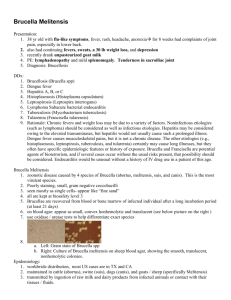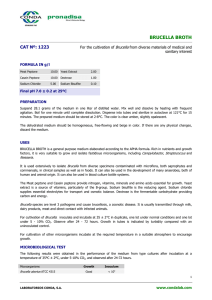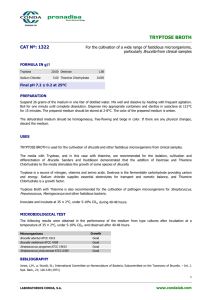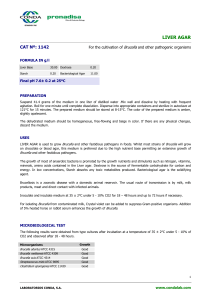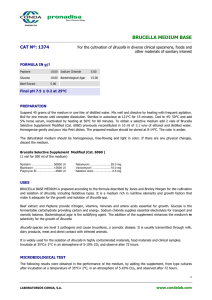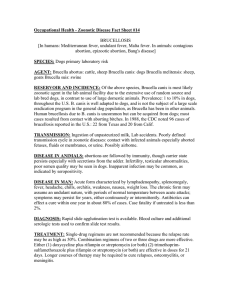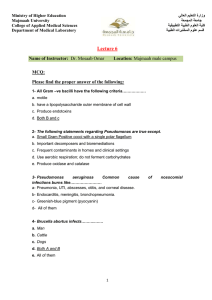Brucella papionis sp. nov., isolated from baboons (Papio spp.)
advertisement
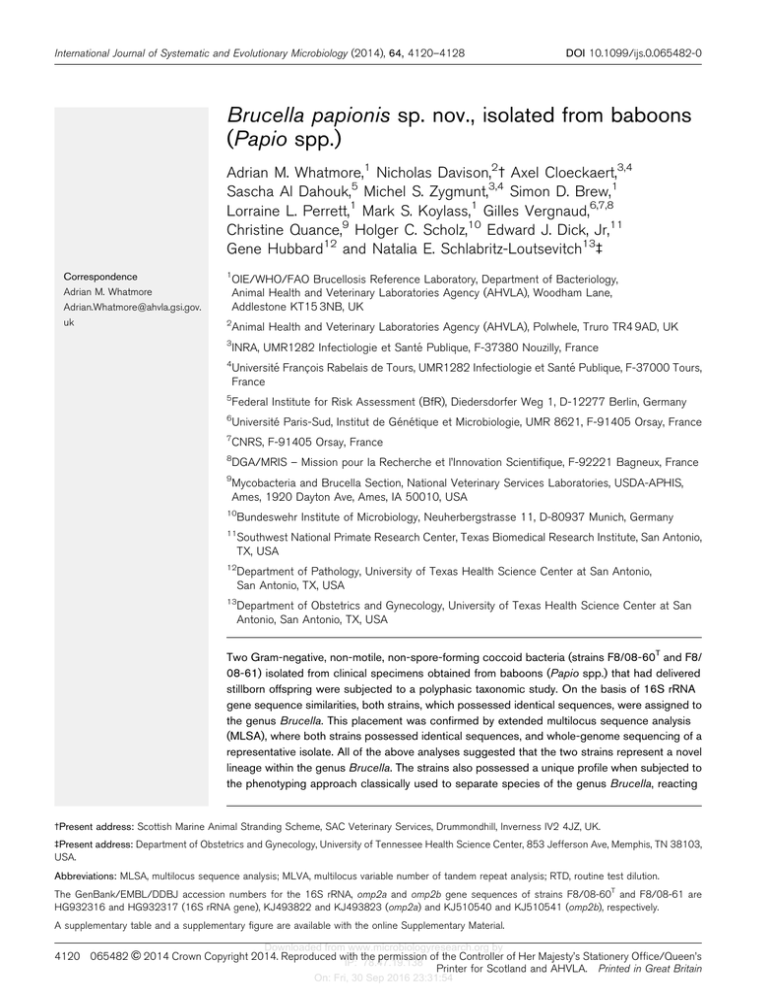
International Journal of Systematic and Evolutionary Microbiology (2014), 64, 4120–4128 DOI 10.1099/ijs.0.065482-0 Brucella papionis sp. nov., isolated from baboons (Papio spp.) Adrian M. Whatmore,1 Nicholas Davison,23 Axel Cloeckaert,3,4 Sascha Al Dahouk,5 Michel S. Zygmunt,3,4 Simon D. Brew,1 Lorraine L. Perrett,1 Mark S. Koylass,1 Gilles Vergnaud,6,7,8 Christine Quance,9 Holger C. Scholz,10 Edward J. Dick, Jr,11 Gene Hubbard12 and Natalia E. Schlabritz-Loutsevitch134 Correspondence Adrian M. Whatmore Adrian.Whatmore@ahvla.gsi.gov. uk 1 OIE/WHO/FAO Brucellosis Reference Laboratory, Department of Bacteriology, Animal Health and Veterinary Laboratories Agency (AHVLA), Woodham Lane, Addlestone KT15 3NB, UK 2 Animal Health and Veterinary Laboratories Agency (AHVLA), Polwhele, Truro TR4 9AD, UK 3 INRA, UMR1282 Infectiologie et Santé Publique, F-37380 Nouzilly, France 4 Université François Rabelais de Tours, UMR1282 Infectiologie et Santé Publique, F-37000 Tours, France 5 Federal Institute for Risk Assessment (BfR), Diedersdorfer Weg 1, D-12277 Berlin, Germany 6 Université Paris-Sud, Institut de Génétique et Microbiologie, UMR 8621, F-91405 Orsay, France 7 CNRS, F-91405 Orsay, France 8 DGA/MRIS – Mission pour la Recherche et l’Innovation Scientifique, F-92221 Bagneux, France 9 Mycobacteria and Brucella Section, National Veterinary Services Laboratories, USDA-APHIS, Ames, 1920 Dayton Ave, Ames, IA 50010, USA 10 Bundeswehr Institute of Microbiology, Neuherbergstrasse 11, D-80937 Munich, Germany 11 Southwest National Primate Research Center, Texas Biomedical Research Institute, San Antonio, TX, USA 12 Department of Pathology, University of Texas Health Science Center at San Antonio, San Antonio, TX, USA 13 Department of Obstetrics and Gynecology, University of Texas Health Science Center at San Antonio, San Antonio, TX, USA Two Gram-negative, non-motile, non-spore-forming coccoid bacteria (strains F8/08-60T and F8/ 08-61) isolated from clinical specimens obtained from baboons (Papio spp.) that had delivered stillborn offspring were subjected to a polyphasic taxonomic study. On the basis of 16S rRNA gene sequence similarities, both strains, which possessed identical sequences, were assigned to the genus Brucella. This placement was confirmed by extended multilocus sequence analysis (MLSA), where both strains possessed identical sequences, and whole-genome sequencing of a representative isolate. All of the above analyses suggested that the two strains represent a novel lineage within the genus Brucella. The strains also possessed a unique profile when subjected to the phenotyping approach classically used to separate species of the genus Brucella, reacting 3Present address: Scottish Marine Animal Stranding Scheme, SAC Veterinary Services, Drummondhill, Inverness IV2 4JZ, UK. 4Present address: Department of Obstetrics and Gynecology, University of Tennessee Health Science Center, 853 Jefferson Ave, Memphis, TN 38103, USA. Abbreviations: MLSA, multilocus sequence analysis; MLVA, multilocus variable number of tandem repeat analysis; RTD, routine test dilution. The GenBank/EMBL/DDBJ accession numbers for the 16S rRNA, omp2a and omp2b gene sequences of strains F8/08-60T and F8/08-61 are HG932316 and HG932317 (16S rRNA gene), KJ493822 and KJ493823 (omp2a) and KJ510540 and KJ510541 (omp2b), respectively. A supplementary table and a supplementary figure are available with the online Supplementary Material. Downloaded from www.microbiologyresearch.org by 4120 065482 G 2014 Crown Copyright 2014. Reproduced with the permission of the Controller of Her Majesty’s Stationery Office/Queen’s IP: 78.47.19.138 Printer for Scotland and AHVLA. Printed in Great Britain On: Fri, 30 Sep 2016 23:31:54 Brucella papionis sp. nov. from baboons only with Brucella A monospecific antiserum, being sensitive to the dyes thionin and fuchsin, being lysed by bacteriophage Wb, Bk2 and Fi phage at routine test dilution (RTD) but only partially sensitive to bacteriophage Tb, and with no requirement for CO2 and no production of H2S but strong urease activity. Biochemical profiling revealed a pattern of enzyme activity and metabolic capabilities distinct from existing species of the genus Brucella. Molecular analysis of the omp2 locus genes showed that both strains had a novel combination of two highly similar omp2b gene copies. The two strains shared a unique fingerprint profile of the multiple-copy Brucella-specific element IS711. Like MLSA, a multilocus variable number of tandem repeat analysis (MLVA) showed that the isolates clustered together very closely, but represent a distinct group within the genus Brucella. Isolates F8/08-60T and F8/08-61 could be distinguished clearly from all known species of the genus Brucella and their biovars by both phenotypic and molecular properties. Therefore, by applying the species concept for the genus Brucella suggested by the ICSP Subcommittee on the Taxonomy of Brucella, they represent a novel species within the genus Brucella, for which the name Brucella papionis sp. nov. is proposed, with the type strain F8/0860T (5NCTC 13660T5CIRMBP 0958T). The genus Brucella currently comprises ten species, Brucella melitensis, B. abortus, B. suis, B. canis, B. neotomae, B. ovis, B. pinnipedialis, B. ceti, B. microti and B. inopinata (Whatmore, 2009). The latter four species have been described in the last decade after a long period of stability in the taxonomy of the genus Brucella and reflect an ongoing widening of the understanding of the host range of Brucella (Godfroid et al., 2011). Because of the high DNA–DNA relatedness of the six longstanding species (relatedness .70 %), it had been suggested that the genus should be monospecific and consist of B. melitensis only, with six biovars, Melitensis, Abortus, Suis, Ovis, Neotomae and Canis (Verger et al., 1985). However, in 2003, the ICSP Subcommittee on the Taxonomy of Brucella agreed unanimously on a return to the pre-1986 taxonomy of six species, with recognized biovars of B. suis, B. abortus and B. melitensis (Osterman & Moriyón, 2006). Three of the newly described species, B. ceti, B. pinnipedialis and B. microti (Foster et al., 2007; Scholz et al., 2008), conform to the existing pattern of high genetic homogeneity, for example all sharing identical 16S rRNA gene sequences. However, B. inopinata, although clearly much more closely related to Brucella than to the nearest neighbour genus Ochrobactrum (De et al., 2008), substantially extends the described genetic diversity within the group (Scholz et al., 2010; Wattam et al., 2012, 2014). This has led some authors to divide the genus informally into ‘atypical’ Brucella, including B. inopinata and other groups recently isolated from rodents, amphibians and humans but yet to be formally described taxonomically (Tiller et al., 2010a, b; Eisenberg et al., 2012; Fischer et al., 2012), and ‘core’ Brucella, representing the nine remaining genetically conserved species that cluster with the longstanding ‘classical’ species of the genus Brucella. Historically, classification of species of the genus Brucella has been based on a combination of host species preference and phenotypic biotyping, which examines a range of characteristics including CO2 requirement, H2S production, dye-sensitivity, lysis by Brucella-specific bacteriophage http://ijs.sgmjournals.org and agglutination with monospecific sera. Phenotyping is still used widely, at least in reference laboratories, although its limitations are increasingly widely recognized, and the emergence of novel species is further eroding its value. Recent descriptions have relied heavily on additional data from emerging molecular approaches, and a process of updating the minimal standards to describe novel species of the genus Brucella, written almost 40 years ago (Corbel & Brinley-Morgan, 1975), to reflect these approaches is ongoing within the current ICSP Subcommittee on the Taxonomy of Brucella (http://icsp.org/subcommittee/brucella/). Here, we describe the classification of two strains (AHVLA F8/08-60T5Baboon 157195NVSL 07-0026-1 and AHVLA F8/08-615Baboon 153315NVSL 07-0224-1, referred to hereafter as F8/08-60T and F8/08-61) that were isolated in 2006 and 2007 from two cases of stillbirth and retained placenta in baboons at a primate research centre in Texas, USA (Schlabritz-Loutsevitch et al., 2009). The index case was a 13-year-old baboon captured in Tanzania with a history of three previous pregnancies, including one abortion/ stillbirth. The suspect Brucella isolate (F8/08-60T) was isolated from a cervical swab obtained following a stillbirth in August 2006. Banked sera from the animal were serologically positive for Brucella using testing validated for B. abortus in cattle (Brewers’ Diagnostic kits; Hynson, Westcott and Dunning Inc.). A second isolate (F8/08-61) was obtained from a swab of uterine content in January 2007, 1 month after a stillbirth in an 8-year-old colony-born baboon with no previous contact with the index case. This animal was serologically negative for Brucella. Phenotypic analysis was performed by characterizing growth on different media, CO2 requirement, H2S production, growth in the presence of dyes (thionin and basic fuchsin), reaction with Brucella unabsorbed and monospecific A and M antisera and microscopy. Metabolic activity in comparison with other strains of Brucella was assessed using API 20E, API 20NE and API ZYM (bioMérieux), with some confirmatory standalone biochemical Downloaded from www.microbiologyresearch.org by IP: 78.47.19.138 On: Fri, 30 Sep 2016 23:31:54 4121 A. M. Whatmore and others testing and application of the Micronaut BfR Brucella assay (Al Dahouk et al., 2010). Molecular analysis comprised multiplex PCR, DNA–DNA hybridization studies (Ziemke et al., 1998), 16S rRNA gene sequence analysis, omp2a and omp2b sequencing, multilocus sequence analysis (MLSA), multilocus variable number of tandem repeat analysis (MLVA with 16 loci) and IS711 fingerprinting, all of which have been used in recent descriptions of novel species of the genus Brucella, with recently completed whole-genome sequencing supporting the findings. Phenotypic analysis Both isolates grew slowly on sheep blood agar (SBA) after incubation both aerobically and in CO2, with small, raised, circular, convex, non-haemolytic, greyish colonies, ~0.5 mm in diameter, appearing after 3 days of incubation at 37 uC, increasing to ~1 mm in diameter after 6 days. Growth was poor at 28 uC. On Farrell’s agar, growth also occurred without additional CO2, with both isolates producing pinpoint colonies after 3 days of incubation at 37 uC, becoming cream in colour, circular, entire, convex and ~0.5–1 mm in diameter after 6 days of incubation. On serum dextrose agar (SDA), growth was apparent after 24 h at 37 uC without additional CO2, with colonies of around 1 mm diameter increasing to 3–4 mm in diameter after 72 h of incubation. Colonies were smooth, entire and circular and showed characteristic blue iridescence using obliquely transmitted light (Henry, 1933). Growth was poor at 28 uC. On nutrient agar, there was poor growth at 37 uC and no growth at 28 uC. Both isolates were sensitive to doxycycline (MIC ,0.016 mg ml21), rifampicin (MIC 0.032 mg ml21), ciprofloxacin [MIC 0.094 mg ml21 (F8/08-60) and 0.064 mg ml21 (F8/08-61)] and streptomycin [MIC 0.125 mg ml21 (F8/08-60) and 0.094 mg ml21 (F8/08-61)] on SDA and failed to grow in nutrient both with 6 % NaCl. Cells of both isolates were Gram-negative cocci, coccobacilli or short rods, approximately 0.5–0.7 mm in diameter and 0.5–1.5 mm long, arranged singly or, occasionally, in pairs, small groups and chains. Both isolates were consistent with Brucella using the modified Ziehl–Neelsen stain (Brinley-Morgan et al., 1978), being resistant to decolourization with 0.5 % acetic acid. Flagellation was determined by transmission electron microscopy. Both isolates were dried onto Formvar/carbon-coated support grids that had been subjected to plasma glow discharge, negatively stained with 2 % phosphotungstic acid (pH 6.6) and examined immediately in a Phillips CM10 transmission electron microscope at 80 kV. Cells were unflagellated coccobacilli, approximately 0.5–1.0 mm long, arranged as individual cells or irregular clusters (Fig. 1). Both isolates were examined by slide agglutination test using unabsorbed Brucella antiserum, negative control serum and sterile normal saline, and agglutinated with Brucella antiserum but not with either the negative control or saline. Using classical phenotyping approaches that are traditionally used to divide the genus Brucella into species and 4122 1 mm 500 nm Fig. 1. Electron micrographs showing non-flagellated cells of strain F8/08-61. The appearance of cells of strain F8/08-60T was identical. biovars (Alton et al., 1988), the organism did not conform to the characteristics of any recognized species of Brucella (Table 1). The unusual profile includes no requirement for CO2, no production of H2S, strong urease activity, sensitivity to the dyes thionin and basic fuchsin at 1 : 50 000, agglutination only with monospecific anti-A serum, and lysis with bacteriophages Wb, Bk2 and Fi. With regard to the strong urease activity, F8/08-60T has been reported previously to share mutations with the urease-negative B. ovis in one of two urease clusters (Wattam et al., 2014), such as changes in the ure2 cluster that make ureF a pseudogene. However, analysis of ureC of the ure1 cluster shows that B. ovis has a 30 bp deletion that is not shared by F8/08-60T. This deletion is probably the significant factor in the different urease activity of B. ovis and the novel strains, as it has been shown that urease activity can be restored in B. ovis by complementation with ureC from B. melitensis (Tsolis et al., 2009). Downloaded from www.microbiologyresearch.org by International Journal of Systematic and Evolutionary Microbiology 64 IP: 78.47.19.138 On: Fri, 30 Sep 2016 23:31:54 http://ijs.sgmjournals.org Table 1. Characteristics that differentiate the novel strains from other species and biovars of the genus Brucella based on classical biotyping approaches Biovars are listed for B. abortus, B. suis and B. melitensis. The status of B. abortus biovar 7 is under investigation (Garin-Bastuji et al., 2014). Other reference species: 1, B. ovis; 2, B. canis; 3, B. neotomae; 4, B. ceti; 5, B. pinnipedialis; 6, B. microti; 7, B. inopinata. (+), Most strains positive; (2), most strains negative; RTD, routine test dilution; ND, no data available. Characteristic F8/08-60T and F8/08-61 B. abortus 1 Urease Requirement for CO2 Production of H2S Growth on media containing: ThioninD FuchsinD Agglutination with monospecific antisera A M R Lysis by phage at RTD# Tb Wb Bk2 Fi R/C Tb6104 + 2 2 2 3 4 5 B. suis 6 7 B. melitensis 9 1 2 3 4 5 1 2 3 (+)* + + + + + + + (+) (+) (+) (+) 2 2 2 2 + + + + 2 (+) (+) + + 2 + + + 2 2 2 2 + 2 2 + + 2 2 2 2 + 2 2 + 2 2 1 2 3 4 5 2 + 2 + 2 2 + 2 + + (2) 2 + (+) 2 + + 2 2 2 + + + (+) 2 2 2 (+) (+) + + + + + + (+) (2) 2 2 2 + + 2 2 2 + 2 2 +d +§ 2 + +d + + + + + + + + 2|| + + + + + 2 + (2) 2 + + + + + + 2 2 + 2 2 + 2 2 + 2 2 2 2 + + + 2 2 2 2 + 2 2 + + 2 2 2 2 + + 2 2 2 + + 2 2 + 2 2 + + 2 2 2 + 2 2 + + 2 2 + (2) 2 PL/NL L L L L L L L L NL NL NL NL NL NL NL NL NL NL NL/PL NL L L L L L L L L L L L L L L NL NL NL NL NL L L L L L L L L L L L L L L L L L L L NL NL L L L L L L L L L L L PL PL PL PL/L PL NL NL NL NL NL L NL NL NL NL NL NL NL NL NL NL NL NL NL NL NL NL NL L L PL L L L L L L L L L L L L L NL NL NL NL NL + 2 + + 2 2 a a ND 7 ND NL NL L ND L ND ND NL/PL NL/PL NL NL NL NL NL ND ND L ND ND L PL b b NL 6 b L b 4123 Downloaded from www.microbiologyresearch.org by IP: 78.47.19.138 On: Fri, 30 Sep 2016 23:31:54 Brucella papionis sp. nov. from baboons *Reference strain is negative but most field strains are positive. DConcentration 1/50 000 (w/v). dFor more certain differentiation of biotypes 3 and 6, thionin is used at 1/25 000 (w/v) in addition; biovar 3 is positive and biovar 6 is negative. §Some strains of this biotype are inhibited by basic fuchsin. ||Some isolates may be resistant to fuchsin. Weak agglutination. #Tb, Tbilisi; Wb, Weybridge; Bk2, Berkeley; Fi, Firenze; R/C, rough strains; Tb6104, Tb at RTD6104. Results scored as follows: L, confluent lysis; PL, partial lysis; NL, no lysis; NLa, most strains no lysis; Lb, most strains lysis. A. M. Whatmore and others Both isolates were run through API 20E and API 20NE, incubated aerobically at 37 and 30 uC, respectively, and API ZYM (bioMérieux). As observed for other classical species of the genus Brucella, and in contrast to the recently described B. inopinata and B. microti, the isolates showed limited metabolic reactivity. After 24 h of incubation at 37 uC, API 20E strips for both strains showed positive reactions only for urea hydrolysis, the Voges–Proskauer test and fermentation of D-glucose and L-arabinose. Both strips were reincubated for a further 24 h (not normally done under the manufacturer’s instructions), and this did produce a slight colour change in the sorbitol cupule for isolate F8/08-61, perhaps indicating slow fermentation. After 24 h of incubation at 30 uC, the API 20NE strips for both isolates were read: reactions occurred only for urea hydrolysis; there was no reduction of nitrates or indole production. Reincubation of the API 20NE strips for a further 24 h according to the manufacturer’s instructions did not produce any changes to the profile of either isolate. API ZYM strips were inoculated and incubated for 4.5 h according to the manufacturer’s instructions. The two isolates produced identical results: strongly positive for esterase (C4), leucine arylamidase, trypsin, acid phosphatase and naphthol-AS-BI-phosphohydrolase, positive for esterase lipase (C8), valine arylamidase and cystine arylamidase and negative for alkaline phosphatase, lipase (C14), a-chymotrypsin, a- and b-galactosidase, bglucuronidase, a- and b-glucosidase, N-acetyl-b-glucosaminidase, a-mannosidase and a-fucosidase. Oxidase and catalase production were examined. Both isolates produced catalase but were negative for oxidase production by using both pyotest strips (Medical Wire and Equipment) and freshly made oxidase reagent. Urea slopes were also inoculated and both isolates hydrolysed urea rapidly, within 30 min, consistent with the positive urea results recorded on API 20E and API 20NE. Nitrate broths were inoculated with both isolates and incubated for 24 h and 3 days at 37 uC, together with a positive control (Serratia marcescens), negative control (Acinetobacter lwoffii) and an uninoculated broth. Neither isolate reduced nitrate. previously (Hunt et al., 2013). Sequences of 1407 bp obtained from the two isolates were identical and confirmed the identity of the isolates as members of the genus Brucella. The sequences show two nucleotide differences from the sequences of the nine ‘core’ species of the genus Brucella shown previously to share identical 16S rRNA gene sequences (Gee et al., 2004; Al Dahouk et al., 2012) and seven nucleotide differences from the sequence of B. inopinata, the only species of the genus Brucella shown previously to have a divergent 16S rRNA gene sequence (Scholz et al., 2010). Results from DNA–DNA hybridizations using labelled DNA of B. melitensis 16MT showed 79.1±0.7 % DNA relatedness with strain F8/08-60T. This result is in agreement with previous reports (Verger et al., 1985) that showed that, if the 70 % DNA relatedness threshold is applied, species of the genus cannot be separated based on results from DNA–DNA hybridizations. The DNA relatedness to the phylogenetically closest neighbour Ochrobactrum intermedium LMG 3301T was 45.7 %. Both strains produce a strong band of identical size to the control from B. melitensis 16MT in a PCR performed to determine the presence of the Brucella genus-specific bscp31 gene (Baily et al., 1992). Fingerprinting using probes against the Brucella-specific IS711 (Halling et al., 1993) has been shown to be a useful tool for differentiating members of the genus Brucella at the species and/or subspecies level (Ouahrani et al., 1993; Bricker et al., 2000; Dawson et al., 2008). By Southern blot, the two baboon isolates could be seen to share an identical high-copy-number IS711 profile, distinct from any profile seen previously (data not shown). Some of these IS711 copies have been located in the genome sequence of one of the baboon isolates (Audic et al., 2011) and, while some IS711 chromosomal locations are common to other species of the genus Brucella, at least seven may be specific to the baboon isolates. Molecular analysis Two frequently applied multiplex PCRs were applied to the isolates. AMOS (B. abortus, B. melitensis, B. ovis and B. suis) PCR (Bricker & Halling, 1994; Ewalt & Bricker, 2000; Bricker et al., 2003) with additional species-specific primers confirmed that the isolates are members of the genus Brucella because of the generation of the specific 180 bp amplicon. However, both isolates failed to produce any of the expected PCR products that would identify them as members of a known species (Schlabritz-Loutsevitch et al., 2009). The strains were examined by Bruceladder PCR, a multiplex PCR that can differentiate all currently recognized species of the genus Brucella (López-Goñi et al., 2008). The profile of bands obtained was identical to the profile of B. melitensis (data not shown); the existing Bruceladder protocol would therefore need to be adapted to distinguish the species represented by the new isolates. The novel IS711 localities described above give a straightforward means to do this. The virtually complete 16S rRNA gene sequence was determined from both strains using an approach described Studies of DNA polymorphism at the omp2 locus have also been used extensively to characterize the genus Brucella. In addition to classical biochemical reactions, extended metabolic activity was examined using the Micronaut BfR Brucella assay (Merlin Diagnostika), which assesses reactions with 93 different metabolites (Al Dahouk et al., 2010). Once again, and in contrast to B. inopinata and B. microti, the isolates displayed limited metabolic reactivity, especially in sugar metabolism, consistent with the ‘classical’ species group of the genus Brucella (Table S1, available in the online Supplementary Material). Interestingly, the enzyme reaction using H-hydroxyproline-bNA, hitherto defining the genus Brucella (Al Dahouk et al., 2010, 2012), revealed a negative result for the first time. Hence, the novel isolates differ metabolically from existing species of the genus Brucella. 4124 Downloaded from www.microbiologyresearch.org by International Journal of Systematic and Evolutionary Microbiology 64 IP: 78.47.19.138 On: Fri, 30 Sep 2016 23:31:54 Brucella papionis sp. nov. from baboons The baboon strains were shown uniquely to possess two almost-identical copies of omp2b, as observed previously for B. ceti, but distinct from the pattern of B. ceti in being more omp2b-like at the 39 end of both omp2 gene copies (data not shown). Both isolates were examined using an MLSA scheme that characterizes the sequences of 21 independent genomic fragments equating to .10.2 kbp (Whatmore et al., 2007; Al Dahouk et al., 2012). The two baboon isolates shared identical sequences at all loci, but possessed unique alleles at 11 of 21 loci not seen in characterization of over 700 isolates of the genus Brucella representing all known species and biovars. Phylogenetic analysis comparing the baboon isolates with type strains representing all extant species of the genus Brucella and strains of their biovars confirmed that they represent a well-separated lineage related most closely to B. ovis (Fig. 2). Both isolates were typed using the MLVA assay described by Le Flèche et al. (2006) and Al Dahouk et al. (2007) comprising 16 loci (Scholz & Vergnaud, 2013) with an allele-coding convention following version 3.6 of the table for allele assignment at http://mlva.u-psud.fr/brucella/spip. php?rubrique29. All loci could be amplified with the exception of Bruce11. The MLVA genotype is 2–5–0–14–2– 2–5–3 for the eight panel 1 loci (0 reflects lack of amplification at locus Bruce11), 6–36–9 for panel 2A and 2–2–3–4–10 or 2–2–3–5–11 for the most variable panel, 2B. The two strains differ only at loci Bruce16 and Bruce30, typical of the minor variation seen in closely related strains (Garcı́a-Yoldi et al., 2007; Maquart et al., 2009). Fig. S1 shows the relative position of the two strains compared to approximately 1900 different MLVA16 genotypes. In this minimum spanning tree (MST), connecting lines longer than 6 are masked. Seven unconnected groups are B.abortus bv9 NCTC 10507 B.abortus bv6 NCTC 10505 B.abortus bv5 NCTC 10504 B.abortus bv1 NCTC 10093T 0.002 B.abortus bv2 NCTC 10501 B.abortus bv4 NCTC 10503 B.abortus bv3 NCTC 10502 B.melitensis bv2 NCTC 10508 B.melitensis bv1 NCTC 10094T B.melitensis bv3 NCTC 10509 B.neotomae NCTC 10084T B.ovis NCTC 10512T B.papionis B.ceti NCTC 12891T B.pinnipedialis NCTC 12890T B.suis bv5 NCTC 11996 B.microti CCM 4915T B.suis bv2 NCTC 10510 B.suis bv1 NCTC 10316T B.suis bv4 NCTC 11364 B.suis bv3 NCTC 10511 B.canis NCTC 10854T B.inopinata BCCN 09-1T Fig. 2. Phylogenetic analysis of the baboon isolates (indicated by an arrow) in comparison with the type strains (see http://icsp. org/subcommittee/brucella/taxa.html for details of strains) of all species and biovars of the genus Brucella inferred by MLSA. Bar, 0.002 substitutions per nucleotide position. Analysis was performed with the MEGA5 package using the neighbour-joining approach. http://ijs.sgmjournals.org Downloaded from www.microbiologyresearch.org by IP: 78.47.19.138 On: Fri, 30 Sep 2016 23:31:54 4125 A. M. Whatmore and others identified. The largest one contains B. melitensis, B. abortus, B. pinnipedialis, B. ceti, B. suis biovar 5 and B. microti. The second largest is made up by B. suis biovar 2. The third group aggregates B. canis and B. suis biovars 1, 3 and 4. B. inopinata, B. ovis, B. neotomae and the novel strains constitute the last four groups. In addition, one of the isolates (F8/08-60T) was subjected to whole-genome sequencing. Two independent comparative genomic analyses have been published based on this sequence (Audic et al., 2011; Wattam et al., 2014), comparing this strain with the type strains of all other species of the genus Brucella. Both analyses confirmed the phylogenetic position suggested by MLSA, showing the baboon isolate and B. ovis united by an extremely shallow branch, indicating a shared common ancestor, but with the long branch length indicative of significant divergence since that time (data not shown). Further, the in silico MLVA genotyping tool accessible at http://mlva.u-psud.fr was applied to the whole-genome sequence (WGS). The deduced code was exactly as determined by PCR and electrophoresis size measurement, illustrating that tandem repeats in Brucella have been correctly assembled from the initial 454 WGS sequence data. Investigation of the WGS data showed that one of the two flanking sequences of the Bruce11 VNTR contains an approximately 141 bp deletion (101 bp of flanking sequence, 40 bp of 63 bp of the first repeat unit, plus potentially an unknown number of full repeat units). This explains the lack of amplification of Bruce11 in the novel strains, since one of the usual Bruce11 PCR primers is within this deletion. If primer 59GTAGCGATTGACACCTTGCCTG is used instead of 59CTGTTGATCTGACCTTGCAACC, an identical 396 bp PCR product is obtained from the two strains, whereas the Bruce11 PCR product is 93 bp longer in the other strains of Brucella (data not shown). Conclusions In summary, extensive phenotypic and genotypic analyses demonstrate that isolates F8/08-60T and F8/08-61 are members of the genus Brucella, but can be differentiated clearly from all established species of this genus, including their biovars. Hence, by applying the species concept for the genus Brucella suggested by the ICSP Subcommittee on the Taxonomy of Brucella (Osterman & Moriyón, 2006), the two strains represent a novel species of the genus Brucella, for which we propose the name Brucella papionis sp. nov. Description of Brucella papionis sp. nov. Brucella papionis (pa.pi.o9nis. N.L. gen. n. papionis of the baboon, from which the first strains of this species were isolated). Cocci, coccobacilli or short rods, ~0.5–0.7 mm in diameter and ~0.5–1.5 mm long, arranged singly and occasionally in pairs, small groups and chains. Gram-negative and resistant 4126 to decolourization with 0.5 % acetic acid. Non-motile and non-spore-forming. Aerobic. Does not require supplementary CO2 for growth. Growth occurs at 30–37 uC. Colonies on SBA and Farrell’s agar are visible at 3–4 days and are small, raised, circular, entire and convex, ~0.5–1 mm in diameter. Non-haemolytic and greyish in colour (on SBA) or honey-coloured (on Farrell’s agar). No growth occurs on MacConkey agar. No growth in broth with 6.5 % NaCl. Isolates do not grow in the presence of thionin or basic fuchsin at 1/50 000. Both known strains agglutinate with monospecific anti-A serum but not anti-M or anti-R serum. Cells are lysed by Wb, Bk2 and Fi phage at routine test dilution (RTD). Cells are sensitive to doxycycline, rifampicin, ciprofloxacin and streptomycin. Catalase-positive. Oxidasenegative. Strongly urease-positive. Negative for indole hydrolysis. No production of H2S. Acetoin is produced (Vogues–Proskauer test). Nitrates are not reduced. No production of arginine dihydrolase, lysine decarboxylase, ornithine decarboxylase, b-galactosidase, b-glucosidase or gelatinase. Positive (API 20E) for fermentation of Larabinose and D-glucose (weak at 37 uC but not 30 uC) and variable, but weak, fermentation of D-sorbitol. No fermentation or oxidation of D-mannitol, inositol, Lrhamnose, sucrose, melibiose or amygdalin at 37 uC. No assimilation of D-glucose, L-arabinose, D-mannose, Dmannitol, maltose, N-acetylglucosamine, potassium gluconate, capric acid, adipic acid, malic acid, trisodium citrate or phenylacetic acid at 30 uC. Esterase (C4), esterase lipase (C8), leucine arylamidase, valine arylamidase, cystine arylamidase, trypsin, acid phosphatase and naphthol-AS-BIphosphohydrolase are produced. Alkaline phosphatase, lipase (C14), a-chymotrypsin, a-galactosidase, b-glucuronidase, a-glucosidase, N-acetyl-b-glucosaminidase, a-mannosidase, a-fucosidase and tryptophan deaminase are not produced. Differentiating physiological reactions (Micronaut BfR Brucella assay) of strains F8/08-60T and F8/08-61 with respect to other species of the genus Brucella are given in Table S1. The type strain is F8/08-60T (5NCTC 13660T5CIRMBP 0958T), isolated in 2006 from a cervical swab taken from a baboon (Papio sp.) following stillbirth in an animal handling facility in Texas, USA. Acknowledgements This investigation used resources that were supported by the Southwest National Primate Research Center grant P51 RR013986 from the National Center for Research Resources, National Institutes of Health, and which are currently supported by the Office of Research Infrastructure Programs (ORIP) of the National Institutes of Health through P51 OD011133 and conducted in facilities constructed with support from ORIP through grants 1 C06 RR014578 and 1 C06 RR015456. We thank Bill Cooley for undertaking the electron microscopy work, Yolande Hauck for the MLVA16 typing and Nelly Bernardet, Cornelia Göllner, Anna-Louisa Hauffe and Jakub Muchowski for technical assistance. The work of S. Al D. was supported by a grant from the Federal Institute for Risk Assessment (BfR project no. 1322-503). The work of A. C., M. Z. and G. V. benefited from a grant from the French ‘Direction Générale de l’Armement’ (grant Brucella REI2010 34 0003), Downloaded from www.microbiologyresearch.org by International Journal of Systematic and Evolutionary Microbiology 64 IP: 78.47.19.138 On: Fri, 30 Sep 2016 23:31:54 Brucella papionis sp. nov. from baboons which supports the development of tools for the tracing of dangerous pathogens. Brucellosis research and surveillance activities at AHVLA are funded by the UK Department of Environment, Food and Rural Affairs (Defra). Fischer, D., Lorenz, N., Heuser, W., Kämpfer, P., Scholz, H. C. & Lierz, M. (2012). Abscesses associated with a Brucella inopinata-like bacterium in a big-eyed tree frog (Leptopelis vermiculatus). J Zoo Wildl Med 43, 625–628. Foster, G., Osterman, B. S., Godfroid, J., Jacques, I. & Cloeckaert, A. (2007). Brucella ceti sp. nov. and Brucella pinnipedialis sp. nov. for References Al Dahouk, S., Flèche, P. L., Nöckler, K., Jacques, I., Grayon, M., Scholz, H. C., Tomaso, H., Vergnaud, G. & Neubauer, H. (2007). Evaluation of Brucella MLVA typing for human brucellosis. J Microbiol Methods 69, 137–145. Al Dahouk, S., Scholz, H. C., Tomaso, H., Bahn, P., Göllner, C., Karges, W., Appel, B., Hensel, A., Neubauer, H. & Nöckler, K. (2010). Differential phenotyping of Brucella species using a newly developed semi-automated metabolic system. BMC Microbiol 10, 269. Al Dahouk, S., Hofer, E., Tomaso, H., Vergnaud, G., Le Flèche, P., Cloeckaert, A., Koylass, M. S., Whatmore, A. M., Nöckler, K. & Scholz, H. C. (2012). Intraspecies biodiversity of the genetically homologous species Brucella microti. Appl Environ Microbiol 78, 1534–1543. Alton, G. G., Jones, L. M., Angus, R. D. & Verger, J. M. (1988). Techniques for the Brucellosis Laboratory. Paris: INRA. Audic, S., Lescot, M., Claverie, J. M., Cloeckaert, A. & Zygmunt, M. S. (2011). The genome sequence of Brucella pinnipedialis B2/94 sheds light on the evolutionary history of the genus Brucella. BMC Evol Biol 11, 200. Baily, G. G., Krahn, J. B., Drasar, B. S. & Stoker, N. G. (1992). Detection of Brucella melitensis and Brucella abortus by DNA amplification. J Trop Med Hyg 95, 271–275. Bricker, B. J. & Halling, S. M. (1994). Differentiation of Brucella abortus bv. 1, 2, and 4, Brucella melitensis, Brucella ovis, and Brucella suis bv. 1 by PCR. J Clin Microbiol 32, 2660–2666. Bricker, B. J., Ewalt, D. R., MacMillan, A. P., Foster, G. & Brew, S. (2000). Molecular characterization of Brucella strains isolated from marine mammals. J Clin Microbiol 38, 1258–1262. Bricker, B. J., Ewalt, D. R., Olsen, S. C. & Jensen, A. E. (2003). Evaluation of the Brucella abortus species-specific polymerase chain reaction assay, an improved version of the Brucella AMOS polymerase chain reaction assay for cattle. J Vet Diagn Invest 15, 374–378. Brinley Morgan, W. J., Mackinnon, D. J., Gill, K. P. W., Gower, S. G. M. & Norris, P. J. W. (1978). Brucellosis Diagnosis, Standard Laboratory Techniques, 2nd edn. Weybridge, UK: Central Veterinary Laboratory, Ministry of Agriculture, Fisheries and Food. Corbel, M. J. & Brinley-Morgan, W. J. (1975). Proposal for minimal standards for descriptions of new species and biotypes of the genus Brucella. Int J Syst Bacteriol 25, 83–89. Dawson, C. E., Stubberfield, E. J., Perrett, L. L., King, A. C., Whatmore, A. M., Bashiruddin, J. B., Stack, J. A. & Macmillan, A. P. (2008). Phenotypic and molecular characterisation of Brucella isolates from marine mammals. BMC Microbiol 8, 224. Brucella strains with cetaceans and seals as their preferred hosts. Int J Syst Evol Microbiol 57, 2688–2693. Garcı́a-Yoldi, D., Le Fleche, P., Marı́n, C. M., De Miguel, M. J., Muñoz, P. M., Vergnaud, G. & López-Goñi, I. (2007). Assessment of genetic stability of Brucella melitensis Rev 1 vaccine strain by multiple-locus variable-number tandem repeat analysis. Vaccine 25, 2858–2862. Garin-Bastuji, B., Mick, V., Le Carrou, G., Allix, S., Perrett, L. L., Dawson, C. E., Groussaud, P., Stubberfield, E. J., Koylass, M. & Whatmore, A. M. (2014). Examination of taxonomic uncertainties surrounding Brucella abortus bv. 7 by phenotypic and molecular approaches. Appl Environ Microbiol 80, 1570–1579. Gee, J. E., De, B. K., Levett, P. N., Whitney, A. M., Novak, R. T. & Popovic, T. (2004). Use of 16S rRNA gene sequencing for rapid confirmatory identification of Brucella isolates. J Clin Microbiol 42, 3649–3654. Godfroid, J., Scholz, H. C., Barbier, T., Nicolas, C., Wattiau, P., Fretin, D., Whatmore, A. M., Cloeckaert, A., Blasco, J. M. & other authors (2011). Brucellosis at the animal/ecosystem/human interface at the beginning of the 21st century. Prev Vet Med 102, 118–131. Halling, S. M., Tatum, F. M. & Bricker, B. J. (1993). Sequence and characterization of an insertion sequence, IS711, from Brucella ovis. Gene 133, 123–127. Henry, B. S. (1933). Dissociation in the genus Brucella. J Infect Dis 52, 374–402. Hunt, B., Bidewell, C., Koylass, M. S. & Whatmore, A. M. (2013). A novel taxon within the genus Actinobacillus isolated from alpaca (Vicugna pacos) in the United Kingdom. Vet Microbiol 163, 383–387. Le Flèche, P., Jacques, I., Grayon, M., Al Dahouk, S., Bouchon, P., Denoeud, F., Nöckler, K., Neubauer, H., Guilloteau, L. A. & Vergnaud, G. (2006). Evaluation and selection of tandem repeat loci for a Brucella MLVA typing assay. BMC Microbiol 6, 9. López-Goñi, I., Garcı́a-Yoldi, D., Marı́n, C. M., de Miguel, M. J., Muñoz, P. M., Blasco, J. M., Jacques, I., Grayon, M., Cloeckaert, A. & other authors (2008). Evaluation of a multiplex PCR assay (Bruce- ladder) for molecular typing of all Brucella species, including the vaccine strains. J Clin Microbiol 46, 3484–3487. Maquart, M., Le Flèche, P., Foster, G., Tryland, M., Ramisse, F., Djønne, B., Al Dahouk, S., Jacques, I., Neubauer, H. & other authors (2009). MLVA-16 typing of 295 marine mammal Brucella isolates from different animal and geographic origins identifies 7 major groups within Brucella ceti and Brucella pinnipedialis. BMC Microbiol 9, 145. Osterman, B. & Moriyón, I. (2006). International Committee on De, B. K., Stauffer, L., Koylass, M. S., Sharp, S. E., Gee, J. E., Helsel, L. O., Steigerwalt, A. G., Vega, R., Clark, T. A. & other authors (2008). Systematics of Prokaryotes; Subcommittee on the Taxonomy of Brucella: minutes of the meeting, 17 September 2003, Pamplona, Spain. Int J Syst Evol Microbiol 56, 1173–1175. Novel Brucella strain (BO1) associated with a prosthetic breast implant infection. J Clin Microbiol 46, 43–49. Ouahrani, S., Michaux, S., Sri Widada, J., Bourg, G., Tournebize, R., Ramuz, M. & Liautard, J.-P. (1993). Identification and sequence Eisenberg, T., Hamann, H. P., Kaim, U., Schlez, K., Seeger, H., Schauerte, N., Melzer, F., Tomaso, H., Scholz, H. C. & other authors (2012). Isolation of potentially novel Brucella spp. from frogs. Appl analysis of IS6501, an insertion sequence in Brucella spp.: relationship between genomic structure and the number of IS6501 copies. J Gen Microbiol 139, 3265–3273. Environ Microbiol 78, 3753–3755. Schlabritz-Loutsevitch, N. E., Whatmore, A. M., Quance, C. R., Koylass, M. S., Cummins, L. B., Dick, E. J., Jr, Snider, C. L., Cappelli, D., Ebersole, J. L. & other authors (2009). A novel Brucella isolate in Ewalt, D. R. & Bricker, B. J. (2000). Validation of the abbreviated Brucella AMOS PCR as a rapid screening method for differentiation of Brucella abortus field strain isolates and the vaccine strains, 19 and RB51. J Clin Microbiol 38, 3085–3086. http://ijs.sgmjournals.org association with two cases of stillbirth in non-human primates – first report. J Med Primatol 38, 70–73. Downloaded from www.microbiologyresearch.org by IP: 78.47.19.138 On: Fri, 30 Sep 2016 23:31:54 4127 A. M. Whatmore and others Scholz, H. C. & Vergnaud, G. (2013). Molecular characterisation of Verger, J.-M., Grimont, F., Grimont, P. A. D. & Grayon, M. (1985). Brucella species. Rev Sci Tech 32, 149–162. Brucella, a monospecific genus as shown by deoxyribonucleic acid hybridization. Int J Syst Bacteriol 35, 292–295. Scholz, H. C., Hubalek, Z., Sedlácek, I., Vergnaud, G., Tomaso, H., Al Dahouk, S., Melzer, F., Kämpfer, P., Neubauer, H. & other authors (2008). Brucella microti sp. nov., isolated from the common vole Microtus arvalis. Int J Syst Evol Microbiol 58, 375–382. Scholz, H. C., Nöckler, K., Göllner, C., Bahn, P., Vergnaud, G., Tomaso, H., Al Dahouk, S., Kämpfer, P., Cloeckaert, A. & other authors (2010). Brucella inopinata sp. nov., isolated from a breast implant infection. Int J Syst Evol Microbiol 60, 801–808. Tiller, R. V., Gee, J. E., Frace, M. A., Taylor, T. K., Setubal, J. C., Hoffmaster, A. R. & De, B. K. (2010a). Characterization of novel Brucella strains originating from wild native rodent species in North Queensland, Australia. Appl Environ Microbiol 76, 5837–5845. Wattam, A. R., Inzana, T. J., Williams, K. P., Mane, S. P., Shukla, M., Almeida, N. F., Dickerman, A. W., Mason, S., Moriyón, I. & other authors (2012). Comparative genomics of early-diverging Brucella strains reveals a novel lipopolysaccharide biosynthesis pathway. MBio 3, e00246-12. Wattam, A. R., Foster, J. T., Mane, S. P., Beckstrom-Sternberg, S. M., Beckstrom-Sternberg, J. M., Dickerman, A. W., Keim, P., Pearson, T., Shukla, M. & other authors (2014). Comparative phylogenomics and evolution of the Brucellae reveal a path to virulence. J Bacteriol 196, 920–930. Whatmore, A. M. (2009). Current understanding of the genetic Tiller, R. V., Gee, J. E., Lonsway, D. R., Gribble, S., Bell, S. C., Jennison, A. V., Bates, J., Coulter, C., Hoffmaster, A. R. & De, B. K. (2010b). Identification of an unusual Brucella strain (BO2) from a diversity of Brucella, an expanding genus of zoonotic pathogens. Infect Genet Evol 9, 1168–1184. lung biopsy in a 52 year-old patient with chronic destructive pneumonia. BMC Microbiol 10, 23. Characterisation of the genetic diversity of Brucella by multilocus sequencing. BMC Microbiol 7, 34. Tsolis, R. M., Seshadri, R., Santos, R. L., Sangari, F. J., Lobo, J. M., de Jong, M. F., Ren, Q., Myers, G., Brinkac, L. M. & other authors (2009). Ziemke, F., Höfle, M. G., Lalucat, J. & Rosselló-Mora, R. (1998). Genome degradation in Brucella ovis corresponds with narrowing of its host range and tissue tropism. PLoS ONE 4, e5519. 4128 Whatmore, A. M., Perrett, L. L. & MacMillan, A. P. (2007). Reclassification of Shewanella putrefaciens Owen’s genomic group II as Shewanella baltica sp. nov. Int J Syst Bacteriol 48, 179– 186. Downloaded from www.microbiologyresearch.org by International Journal of Systematic and Evolutionary Microbiology 64 IP: 78.47.19.138 On: Fri, 30 Sep 2016 23:31:54
